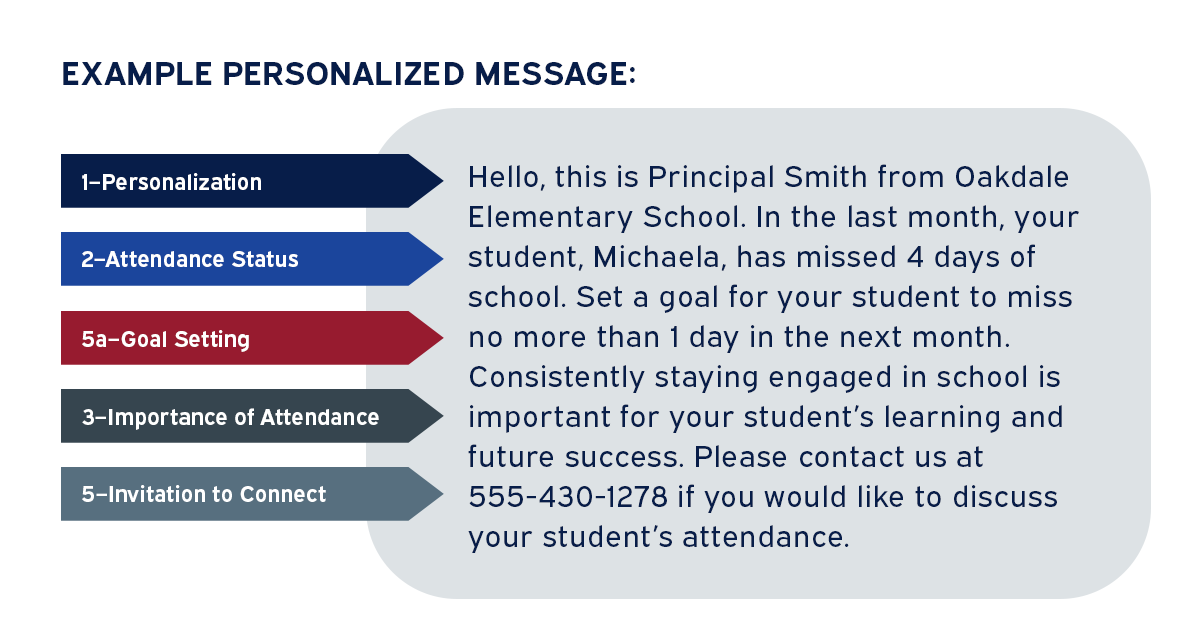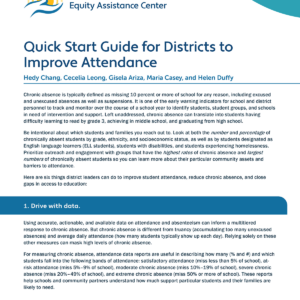Four Strategies to Increase Student Attendance Through Personalized Family Messaging
Posted on

By Sierra McCormick
This post first appeared on the REL Northwest blog and is posted here with permission.
Consistent student attendance is critical to learning and student success.1 Students who are chronically absent are at serious risk of falling behind.2
Outreach from school staff to families and caregivers about their student’s attendance patterns can help reduce absenteeism.3 According to a recent study funded by The National Center for Education Evaluation and Regional Assistance, parent messaging lowered the absentee rate by seven percentage points for students with a history of chronic absence.4
What personalized messaging strategies can educators use to increase student attendance? The National Center for Rural Education Research Networks released a how-to guide, Improve Attendance with Personalized Messages, which outlines four key components of effective messages to families:
- Personalization: Introduce yourself, address the caregiver by name, and include the student’s name.
- Attendance status: Summarize the total number of days absent in the past month.
- Importance of attendance: Emphasize the value of being present in school.
- Invitation to connect: Provide contact information for caregivers to connect with school staff.
Caregivers are often unaware of the number of days their student has missed. By providing real-time, personalized information, educators can increase caregivers’ awareness. These easy-lift actions can also build stronger relationships between educators and caregivers, enabling them to address barriers to attendance and engagement together.
The how-to guide includes messaging templates that educators can customize to fit their needs (pages 7-8). It also offers advice for implementing a district-wide program. The resources below can also help kick-start these efforts.
By incorporating the evidence-based strategy of personalized messaging to families and caregivers into common practice, educators can help increase student attendance. Increased student attendance can help students build their academic skillset and feel a greater sense of belonging at school.5
Additional Resources
- Chronic Absenteeism in Our Nation’s Schools: The U.S. Department of Education report presents national data on absenteeism and disparities by student background characteristics and geography.
- Review of Research on Student Nonenrollment and Chronic Absenteeism: REL Pacific summarizes the underlying factors that lead students to miss school.
- Using Text Message Initiatives for Parent Engagement: REL Southwest’s webinar series, designed for state and district staff covers strategies for using text messages for parent engagement and outreach.
- Exploring Implementation of Attendance Supports to Reduce Chronic Absenteeism in the Providence Public School District: REL Northeast and Islands’ descriptive study assesses the implementation of text messaging, phone calls, and mentorship programs to reduce chronic absenteeism.
- Resources for Engaging Families and the Community as Partners in Education: REL Pacific’s toolkit helps educators plan for effective communication by building trusting relationships with families.
Subscribe to the REL Northwest newsletter, follow us on Twitter, and visit our website to learn more.
Notes
1 U.S. Department of Education. (2016). Chronic Absenteeism in the Nation’s Schools: An unprecedented look at a hidden educational crisis. https://www2.ed.gov/datastory/chronicabsenteeism.html#intro;
Gottfried, M. A. (2015). Chronic absenteeism in the classroom context: Effects on achievement. Urban Education, 54(1), 3-34.
2 Gottfried, M. A. (2014). Chronic absenteeism and its effects on students’ academic and socioemotional outcomes. Journal of Education for Students Placed at Risk, 19(2), 53-75. http://dx.doi.org/10.1080/10824669.2014.962696;
Allensworth, E. M., & Easton, J. Q. (2007). What Matters for Staying On-Track and Graduating in Chicago Public High Schools: A Close Look at Course Grades, Failures, and Attendance in the Freshman Year. Research Report. Consortium on Chicago School Research.
3 Bergman, P., & Chan, E. (2017). Leveraging technology to engage parents at scale: Evidence from a randomized controlled trial. Center for Economic Studies and ifo Institute (CESifo), Munich.
4 Heppen, J.B., Kurki, A., & Brown, S. (2020). Can Texting Parents Improve Attendance in Elementary School? A Test of an Adaptive Messaging Strategy (NCEE 2020–006). Washington, DC: U.S. Department of Education, Institute of Education Sciences, National Center for Education Evaluation and Regional Assistance. Retrieved from http://ies.ed.gov/ncee
5 Gottfried, M. A. (2014). Chronic absenteeism and its effects on students’ academic and socioemotional outcomes. Journal of Education for Students Placed at Risk, 19(2), 53-75. http://dx.doi.org/10.1080/10824669.2014.962696.


